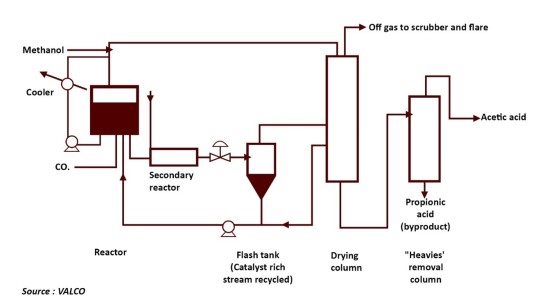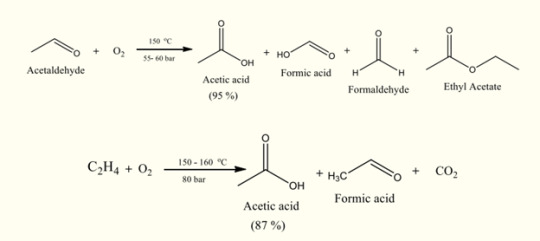#Acetic acid
Photo

Vinegar could be secret ingredient in fight against climate crisis
Chemical engineers at Monash University have developed an industrial process to produce acetic acid that uses the excess carbon dioxide (CO2) in the atmosphere and has a potential to create negative carbon emissions.
Acetic acid is an important chemical used in several industrial processes and is an ingredient in household vinegar, vinyl paints and some glues. Worldwide industrial demand for acetic acid is estimated to be 6.5 million tons per year.
This world-first research, published in Nature Communications, shows that acetic acid can be made from captured CO2 using an economical solid catalyst to replace the liquid rhodium or iridium based catalysts currently used.
Liquid catalysts require additional separation and purification processes. Using a solid catalyst made from a production method that doesn't require further processing also reduces emissions.
Read more.
#Materials Science#Science#Vinegar#Acetic acid#Reactions#Carbon dioxide capture#Catalysts#Liquids#Metal organic framework#Monash University
27 notes
·
View notes
Text
Figure 11.7 shows the different conductivities of aqueous solutions containing HCl and CH3COOH.

"Chemistry" 2e - Blackman, A., Bottle, S., Schmid, S., Mocerino, M., Wille, U.
#book quotes#chemistry#nonfiction#textbook#hydrochloric acid#acetic acid#conductivity#electrical conductivity#aqueous solution
18 notes
·
View notes
Text
Aspirin is synthesised on an industrial scale by reacting acetic anhydride with salicylic acid:

"Chemistry" 2e - Blackman, A., Bottle, S., Schmid, S., Mocerino, M., Wille, U.
#book quote#chemistry#nonfiction#textbook#aspirin#synthesis#chemical reactions#acetic anhydride#salicylic acid#hydroxybenzoic acid#acetylsalicylic acid#acetic acid
2 notes
·
View notes
Photo

#studyblr#notes#organic chemistry#ochem#o-chem#o chem#ochem 1#ochem 2#organic chemistry 1#organic chemistry 2#mcat organic chemistry#orgo#reactions#orgo reactions#chemical reactions#orgo mcat#mcat orgo#ochem reactions#acetic acid#acetyl#acetyl group
7 notes
·
View notes
Text
From Vinegar to Versatility: Unveiling Acetic Acid's Production Journey and Multifaceted Applications

Vinegar. That pantry staple we splash on salads and fries. But did you know this common household item packs a surprising scientific punch? The key ingredient in vinegar is Acetic Acid, a clear, colorless liquid with a powerful odor that's sure to clear your sinuses. Acetic Acid is much more than just a souring agent. It's a workhorse in the chemical world, playing a crucial role in the production of countless everyday items. From the plastics in your water bottle to the medicines in your cabinet, Acetic Acid might be lurking behind the scenes.
In this blog, we'll delve deeper into the fascinating world of Acetic Acid. We'll explore its surprising range of uses, from the industrial to the culinary, and uncover the science behind its unique properties. So, whether you're a curious cook or a science enthusiast, get ready to learn a whole new side to the humble vinegar you know and love!
Introduction
Acetic Acid, a clear organic compound with a strong odor and tart flavor, is industrially synthesized through methanol carbonylation or ethylene oxidation. Methanol carbonylation is the preferred method over ethylene oxidation. Key technology providers for Acetic Acid production include British Petroleum, Celanese, Eastman's acetyls technology, and LyondellBasell. Similar to ethanol, Acetic Acid is a water-friendly solvent, readily mixing with water, chloroform, and hexane, and dissolving substances such as oils, sulfur, and iodine.
It serves as a chemical precursor for various compounds like acetic anhydride, esters, vinyl acetate monomer (VAM), and various polymers. Acetic Acid is also utilized in vinegar production, where it constitutes 5 percent of the solution, finding applications in the food and beverage industry for marinades, pickling solutions, and salad dressings. Additionally, vinegar, containing Acetic Acid, can be added during food preparation to minimize contamination in meat and poultry products.
Manufacturing Process
Acetic Acid primarily undergoes production through chemical methods, utilizing both homogeneous and heterogeneous catalytic processes. The predominant method involves the carbonylation of methanol, a process initially established by Monsanto, which has since progressed into the Cavita process. This evolved approach offers flexibility in catalyst selection and incorporates advancements in process intensification techniques.
Methanol carbonylation process:
• The carbonylation process, commonly referred to as the Monsanto process, stands as the predominant commercial method for synthesizing Acetic Acid.
• Methanol and carbon monoxide undergo a liquid-phase reaction under the influence of a rhodium (Rh)-based catalyst at temperatures ranging between 150 to 200 degrees Celsius and pressures between 30 to 50 bar, yielding Acetic Acid with a selectivity of around 95% and minor side products including formic acid and formaldehyde.
• In this process, hydrogen iodide serves as an alkali promoter, with the reaction occurring in the liquid phase and methyl acetate acting as a solvent using a homogeneous catalyst. The controlled introduction of water is necessary for the reaction, which is generated in situ through the reaction of methanol with hydrogen iodide.
• The reaction rate in the Monsanto process is directly influenced by the concentration of water. Byproducts such as CO2, H2, and methanol are generated during the reaction, with the produced methanol being recycled. Over time, the process has undergone evolution, with various strategies implemented to separate pure Acetic Acid from a mixture of water and byproducts. BP Chemicals modified this process by substituting the rhodium-based catalyst with an Iridium (Ir) catalyst, resulting in what is known as the Cavita process.
• The selection of Ir as a coordination metal presents a relatively more economical approach compared to rhodium. The use of an iridium catalyst enhances the overall reaction rate.
The following chemical reaction represents the same:


Acetaldehyde oxidation process
• The acetaldehyde oxidation method was one of the largely used method used for synthesizing Acetic Acid. Initially, acetaldehyde was prepared through the oxidation of ethylene, employing palladium and copper chloride catalysts, after which it underwent further oxidation to yield Acetic Acid.
• Alternatively, a similar procedure utilizing cobalt and chromium-based catalysts has been documented, operating at a pressure of 55 bar and a temperature of 150 degrees Celsius. Another variant of this process involves a one-step conversion of ethylene to Acetic Acid, employing lead and lead-platinum based catalysts at elevated pressures, in contrast to the acetaldehyde oxidation method, albeit with lower Acetic Acid yields.

Hydrocarbon oxidation process
• Petroleum-derived hydrocarbons, including butane and naphtha, serve as the primary sources for producing Acetic Acid, a crucial chemical compound, through a reaction catalyzed by cobalt acetate and chromium acetate.
• This chemical transformation unfolds within a relatively elevated temperature range of 150-230°C and under pressures ranging from 50 to 60 bar. The utilization of petroleum feedstock, comprising a diverse hydrocarbon blend, initiates a multifaceted reaction pathway leading to the synthesis of not only Acetic Acid but also a spectrum of byproducts, notably acetone, formic acid, and propionic acid, alongside the target compound. Consequently, the resultant Acetic Acid may not exhibit a high degree of purity due to the coexistence of these impurities.
• However, this process's strength lies in its capability to generate a mixture of volatile fatty acids, rendering it more suitable for applications necessitating such a blend. Therefore, while it may not yield pristine Acetic Acid, this method finds relevance in industrial contexts where a mixture of volatile fatty acids is desirable. This underscores the importance of understanding the nuanced outcomes of chemical processes and tailoring them to meet specific industrial requirements.

Applications of Acetic Acid
1. Food & Beverages
Acetic Acid finds its primary application in the culinary sector, predominantly in the form of vinegar. Throughout history, it has served as a condiment, flavor enhancer, and preservative in pickling. Vinegar remains integral in various processed foods, including mayonnaise, due to its typical sour flavor and preserving properties. Acetic Acid finds application in preserving and pickling various food items such as vegetables and fruits, effectively thwarting spoilage and prolonging their shelf life. Its presence contributes to the characteristic tanginess observed in pickled foods.
2. Chemical Intermediates
Acetic Acid serves as a vital chemical reagent in the synthesis of various compounds. Its primary application lies in the production of vinyl acetate monomer, followed closely by acetic anhydride and ester production. While Acetic Acid is commonly associated with vinegar, its usage volume in this context is relatively minor compared to its extensive utilization in industrial processes for the production of essential chemical compounds. Acetic Acid serves as a foundational component in the production of various chemicals, including vinyl acetate, acetic anhydride, and acetate esters. Vinyl acetate is utilized in the synthesis of polyvinyl acetate, a versatile polymer applied in paints, adhesives, plastics, and textile finishes. Acetic anhydride finds application in the manufacturing of cellulose acetate fibers and plastics used in photographic film, clothing, and coatings. Furthermore, Acetic Acid plays a crucial role in the chemical process to produce purified terephthalic acid (PTA), essential for manufacturing PET plastic resin. PET resin is extensively employed in synthetic fibers, food containers, beverage bottles, and plastic films.
3. Cosmetics
Acetic Acid is a common component in many cosmetic items. It serves as an ingredient in hair conditioners, shampoos, and various other hair care products. Additionally, derivatives of Acetic Acid, such as alkyl acetates and acetate salts, contribute to the formulation of perfumes and skin conditioners. These derivatives play crucial roles in enhancing the effectiveness and sensory characteristics of cosmetic formulations, ensuring optimal performance and user satisfaction across a range of personal care applications.
4. Household Cleaners
Due to its acidic nature, Acetic Acid serves as a potent cleaning agent and disinfectant, commonly employed for sanitizing windows, countertops, and various surfaces in both residential and industrial environments. It presents a natural substitute for harsher chemicals and is particularly adept at removing limescale buildup in appliances like kettles and coffee makers. Its versatility extends to diverse cleaning tasks, offering an effective and eco-friendly solution for maintaining cleanliness and hygiene.
Market Outlook
The Acetic Acid market is influenced by the combination of industrial, economic, and regulatory factors. The main factors that drive the demand are the growing need in different industries like textiles, packaging, automotive, and construction, where Acetic Acid is a key component in the production of vinyl acetate monomer (VAM), purified terephthalic acid (PTA), acetate esters, and solvents. Besides, the chemical industry, which is growing especially in the developing countries such as China and India, is one of the factors that leads to the increase of the demand for Acetic Acid since it is a basic material for the production of many chemicals. Besides, the increase in the adhesive and sealant industry, caused by the rising construction activities and the demand for consumer goods, also brings the Acetic Acid demand up. The fast urbanization and the infrastructure development projects across the globe also are the reason behind the growth of the market, as Acetic Acid is a necessary component of the construction materials like paints, coatings, and adhesives.
Acetic Acid Major Global Players
Major players in the Global Acetic Acid market are Celanese Corporation, Eastman Chemical Company, LyondellBasell Industries N.V., Yangtze River Acetyls Co. Ltd (YARACO), The Saudi International Petrochemical Company (Sipchem), INEOS PCG ACETYLS SDN BHD (IPASB), Lotte BP Chemical, Gujarat Narmada Valley Fertilizer and Chemicals, Formosa BP Chemicals Corporation, British Petroleum, Formosa BP Chemicals Corporation, Formosa INEOS Chemicals Corporation (FBPCC), EuroChem Group AG, and Others.
Conclusion:
To sum up, the Acetic Acid market is set to keep on growing and changing due to a wide range of factors such as industrial demand, regulatory shifts and technological advancements. Acetic Acid is a very important chemical which has many applications in all the industries such as textiles, automotive, construction, and so on. Thus, it is the essential chemical for the processes and products. The growing chemical industry, especially in the developing economies, is the evidence of the growing demand of Acetic Acid as a basic chemical in chemical synthesis. Besides, the increasing of adhesive and sealant industry, the rapid urbanization and infrastructure development of the world and the need for Acetic Acid in the construction materials and consumer goods are also the reasons for the growth of the demand for Acetic Acid. Besides, the industry's transformation to the bio-based production methods and sustainability initiatives is proof of the shift towards the more eco-friendly practices. The market will keep on changing; hence it is important for the stakeholders to be up to date with these trends and developments so that they can take advantage of the emerging opportunities and at the same time avoid the possible problems. In a nutshell, the Acetic Acid market is expected to be a great one in the future, due to the innovation, diversification of demand, and sustainability imperatives.
0 notes
Link
1 note
·
View note
Text
Are You Looking For Acetic Acid Manufacturer in USA?
Stellar Exports is a prominent supplier of Acetic Acid in USA and is based in the UAE. As USA's leading Acetic Acid manufacturer and supplier, Our team of experts can tailor Acetic Acid to meet your specific requirements. For more information visit our website.

#Acetic Acid#Acetic Acid manufacturer#Acetic Acid sellers in USA#Acetic Acid supplier in USA#Acetic Acid manufacturers in USA
0 notes
Text


For centuries, acetic acid vinegar, commonly known as vinegar, has held a pivotal role in both culinary practices and household management. Delve into the origins, production, various types, culinary and household uses, as well as potential health benefits of acetic acid vinegar by reading our blog at acetic-acid.net
1 note
·
View note
Text
Acetic Acid Glacial
Acetic Acid Glacial (C2H4O2) is a clear, colorless liquid that is the anhydrous (water-free) form of acetic acid. It contains only 1% water and 99% acetic acid; therefore, it is highly concentrated. It is an acid with a sharp, pungent characteristic odor and a sour taste. Acetic Acid Glacial is also known as ethanoic acid or vinegar concentrate.
It is completely miscible with water, ethanol, glycerol, and diethyl ether. Acetic Acid Glacial can form ice-like crystals when kept below 16.7o C temperature. It is usually developed in laboratories.
It is highly corrosive and potentially flammable.
Acetic acid is used as a food-grade chemical and flavoring agent.
#Acetic acid glacial#laboratory chemical#food grade chemical#flavoring agent#food industries#acetic acid#food preservative
0 notes
Text
Treprostinil

Synonyms: 2-[[(1R,2R,3aS,9aS)-2,3,3a,4,9,9a-Hexahydro-2-hydroxy-1-[(3S)-3-hydroxyoctyl]-1H-benz[f]inden-5-yl]oxy]acetic acidChemical Name: Acetic acid,2-[[(1R,2R,3aS,9aS)-2,3,3a,4,9,9a-hexahydro-2-hydroxy-1-[(3S)-3-hydroxyoctyl]-1H-benz[f]inden-5-yl]oxy]
Know more:- https://www.simsonpharma.com/product/treprostinil
0 notes
Link
Look no further if you want to buy acetic acid for your organization or industry, A-Gas Electronic Materials is a distributor and supplier offering large stocks and competitive rates.
0 notes
Text
Table 23.1 lists several of the unbranched aliphatic carboxylic acids found in the biological world (e.g. figure 23.1), along with the common names of each.


"Chemistry" 2e - Blackman, A., Bottle, S., Schmid, S., Mocerino, M., Wille, U.
#book quotes#chemistry#nonfiction#textbook#aliphatic#carboxylic acid#70s#1670s#17th century#formica#ants#venom#formic acid#acetic acid#propionic acid#butyric acid#valeric acid#caproic acid#caprylic acid#capric acid#lauric acid#myristic acid#palmitic acid#stearic acid#arachidic acid#methanoic acid#ethanoic acid#propanoic acid#butanoic acid#pentanoic acid
4 notes
·
View notes
Text
Common solvents for these reactions are divided into two groups: protic and aprotic.


"Chemistry" 2e - Blackman, A., Bottle, S., Schmid, S., Mocerino, M., Wille, U.
#book quote#chemistry#nonfiction#textbook#solvent#protic#aprotic#water#formic acid#methanol#ethanol#acetic acid#dimethyl sulfoxide#dmso#acetone#dichloromethane#diethyl ether
2 notes
·
View notes
Text
Acetic Acid Market 2022 Global Industry Extensive Competitive Landscape on Size, Volume, Trends, Share and Revenue| Regional Forecast By 2028
Acetic Acid Market 2022 Global Industry Extensive Competitive Landscape on Size, Volume, Trends, Share and Revenue| Regional Forecast By 2028
This report studies the Acetic Acid Market with many aspects of the industry like the market size, market status, market trends and forecast, the report also provides brief information of the competitors and the specific growth opportunities with key market drivers. Find the complete Acetic Acid Market analysis segmented by companies, region, type and applications in the report.
The report…
View On WordPress
#Acetic Acid#Acetic Acid forecast#Acetic Acid Industry#Acetic Acid Market#Acetic Acid price#Acetic Acid report#Acetic Acid research#Acetic Acid share#Acetic Acid trends#Covid-19 Impact Analysis
0 notes
Link
0 notes
Link
1 note
·
View note